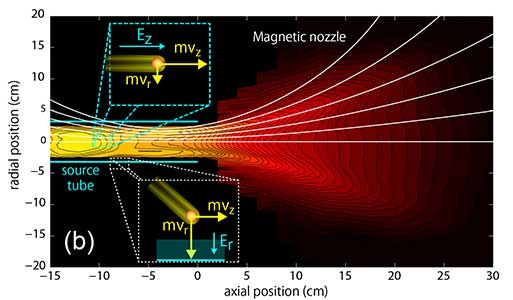

The importance of kinetic effects and of a short-wavelength mode arising at low magnetic fields is evaluated. Experimental data on the waves and the equilibrium properties of the discharge are shown, and the status of our current understanding of the physical processes therein is summarized. How helicon waves are related to whistler waves and waves in a plasma-filled waveguide is explained, and the mystery of the high ionization efficiency is outlined. The experimental program thus demonstrated the potential of the mini-helicon discharge as an excellent space thruster design, given its high throughput, absence of internal electrodes and cathodes, potentially long life time, very low divergence of the plasma plume, flexible choice of propellants, and variable specific impulse.īecause of their high density, low-pressure discharges ionized by helicon waves are being studied for their possible use in cluster tools for the fabrication of next-generation computer chips. Operation with permanent magnets was attempted as well, including a magnetic nozzle and the possibility of a double layer formation. 4MW/(square meter), power density throughput has been achieved in a steady-state regime. Plasma plume flow velocities in the 10 to 40km/sec interval were measured, and plume acceleration could be easily varied by altering applied RF-power or propellant flow rate. The parameters of the plasmas were measured using high-resolution spectroscopic and in-situ diagnostics, including super-fine emission line structure and isotopic shift of a seeded impurity. Stable discharges with well-collimated plume exhaust were achieved for argon (Ar), nitrogen (N2), mixtures of Ar and N2, and air. These objectives were successfully achieved. The program was designed to address several objectives: (i) to achieve a high coupling of RF-power to plasma and efficient acceleration to >20km/sec (ii) to evaluate the scaling relations between power density, flow rates and B-field strength (iii) to demonstrate operation with common molecular and atomic gases, and mixtures (iv) to provide detailed characterization of the performance using spectroscopic and invasive techniques (v) to experimentally demonstrate variable specific impulse capability.

The helicon discharge was designed and built in several different configurations using low- and high-current electromagnets. This system provides the capability for future experimentation and helicon plasma thruster development.Īn experimental program to develop and test a mini-helicon thruster is described. The result of the design and construction effort is a working, reliable, and flexible helicon plasma source system. In addition, a radio frequency matching network enclosure and suitable interconnections were designed and constructed as part of the RF power delivery system. A metallic structure was designed, structurally analyzed and constructed to support the electromagnets used to provide the required magnetic field. An analysis of the flow of propellant through the thruster was completed, utilizing low Mach number flow theory. A survey of past helicon experiment parameters was completed, made possible largely due to the wealth of data provided by helicon plasma use in academia and for research and development. This thesis will focus on the author's specific contributions to this larger effort, which included the following elements. A design process was undertaken for the creation of this experimental setup, with the aid of a number of students and researchers at the MIT SPL. This effort may lead to the development of a new electric propulsion device, the Mini-Helicon Plasma Thruster. The goal was to create a robust and flexible experimental system which would allow optimization of the source and system parameters for efficient thrust generation, and would permit for correlation between helicon theory and experiment. Historical helicon experiment data have been applied to help size the experiment. This experiment allows study of the intrinsic advantages of efficient helicon plasma production for use in space electric propulsion. A helicon plasma source experiment has been developed and then constructed in the MIT Space Propulsion Laboratory (SPL) vacuum chamber.


 0 kommentar(er)
0 kommentar(er)
